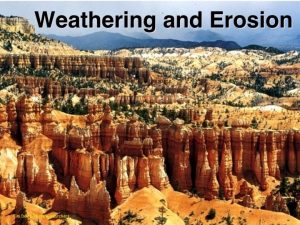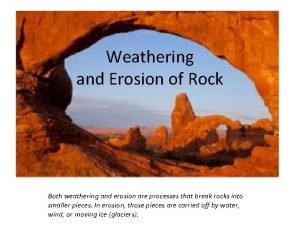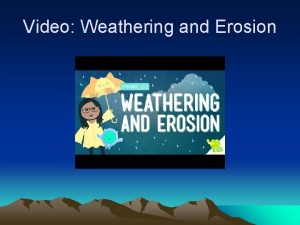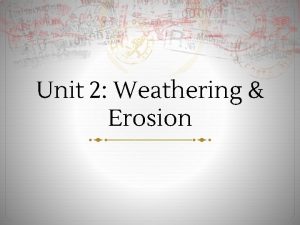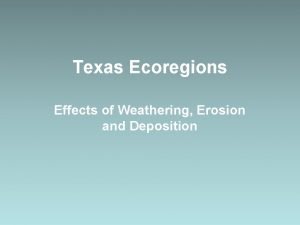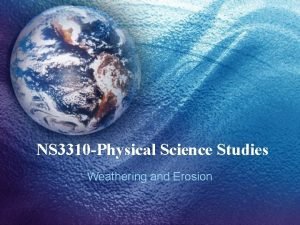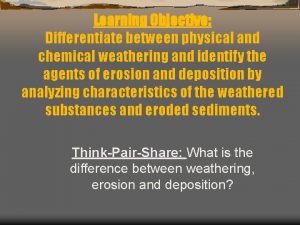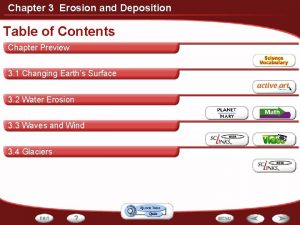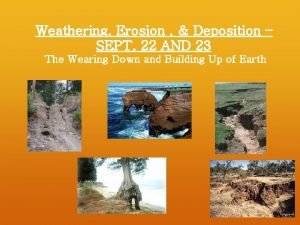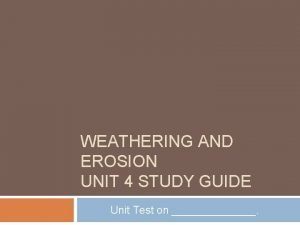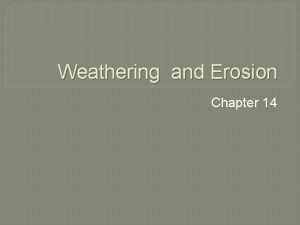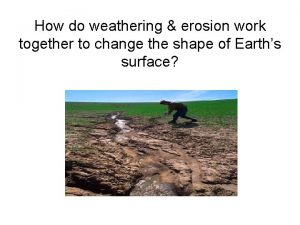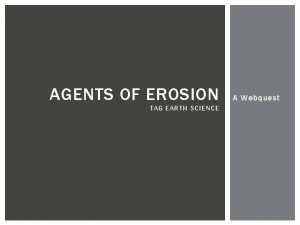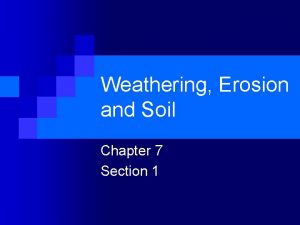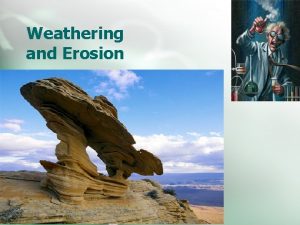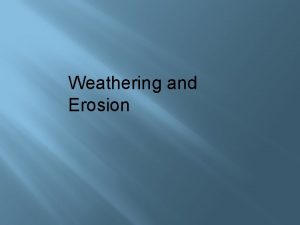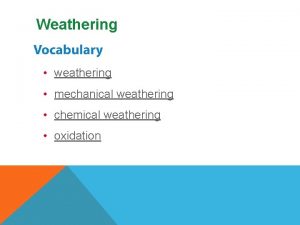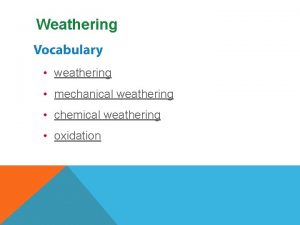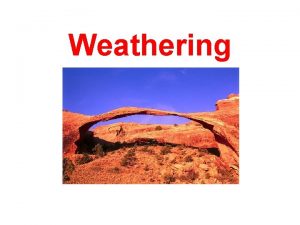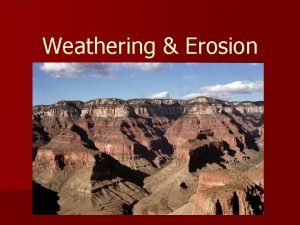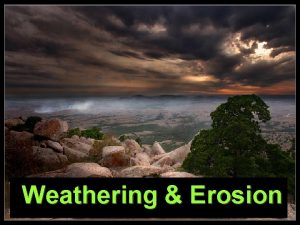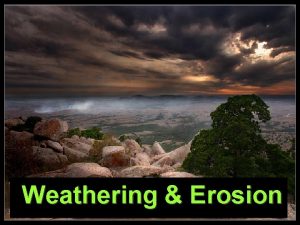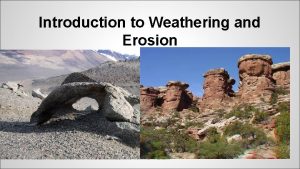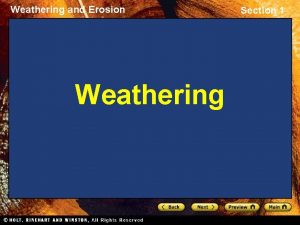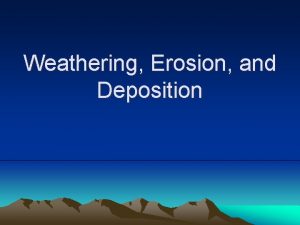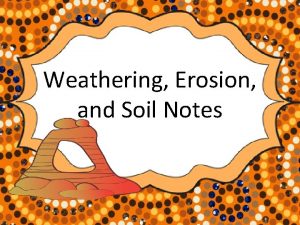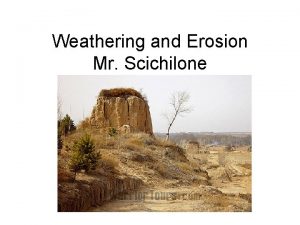DENUDATION Erosion and Weathering Introduction DENUDATION refers to


















- Slides: 18

DENUDATION: Erosion and Weathering

Introduction DENUDATION refers to the wearing down and stripping and leveling of the earths surface. n They are also gradational because they grade/level the earth’s surface. n 2 processes: weathering and erosion. n Weathering is the breakdown of rock and minerals. n Erosion is the movement of these weathered materials. n

Erosion The removal of weathered sediment or rock by the forces of wind, water and ice. n This is a two-fold process: Transportation which is the movement of sediment or weathered material away from its source to another location. n - Deposition which is dropping or settling of sediments.

Weathering n Weathering is the breakdown of rocks and minerals by physical pressures and chemical reactions. n There are two types : physical and chemical.

Physical Weathering n Physical weathering is the breakdown of rock and minerals by mechanical stresses. n 4 types to be discussed… n Physical weathering prevails in: n cold and wet climates n high altitudes and high latitudes n hot/dry regions

1. Physical Weathering - Frost fracture water gets into the cracks of rocks, freezes and expands causing rocks to crack.

2. Physical Weathering – Heat or Thermal Expansion n Repeated daily heating and cooling of rock results in expansion during heating and contraction during cooling. n Different materials expand contract at different rates, resulting in stresses along mineral boundaries.

Heat or Thermal Expansion

3. Physical Weathering - Exfoliation is the breaking off of rocks in curved sheets or slabs along joints that are parallel to the ground surface. n Most commonly the release of stress upon a rock occurs when overlying rock is eroded away. n

Exfoliation

4. Physical Weathering – Plants and animals Expansion due to root growth. Animals that burrow in the ground. ROOTS grown into the rock Could be considered Biological weathering!!!!

Chemical Weathering n Chemical weathering is the breakdown of rocks and minerals by chemical reactions and usually involves the action of rainwater. n This involves three processes:

1. Chemical Weathering – Solution/Dissolution q The formation of solutions as rainwater absorbs CO 2 , SO 2, and other chemicals from the atmosphere along with organic acids from the soil q Which then reacts with rock and minerals causing some to dissolve and move away.

2. Chemical Weathering – Hydrolysis Ø Hydrolysis like the first process involves the minerals in solution. Ø In this case, carbonic acid reacts with silicates in some rocks leaving a soft clay from which potassium, sodium and magnesium are subsequently leached.

3. Chemical Weathering – Oxidation § Oxidation is the reaction of metallic minerals to oxygen (mainly in water. § This results in the formation of oxides, which tend to be softer than the original mineral. § For example, rust on iron.

Relate environmental conditions & rate of physical & chemical weathering • Freezing temperatures and moisture? • Frost Fractures • Variation/fluctuations in H/C temperatures? • Thermal Expansion • Presence of vegetation? • Roots expanding cracks • Heavy precipitation? • Accelerates dissolving of rocks/minerals

Relate environmental conditions & rate of physical & chemical weathering n n n CO 2 and SO 2 in the humid air? n Creates solutions that dissolve some rock and minerals O 2, Moisture and metallic minerals? n Chemical reaction-oxidation, ie. rust Carbonic Acid? n Hydrolysis, transform rock into soft claylike. . leach away High Temperatures? n Accelerates oxidation Oceans and Salt? n Accelerates oxidation

Practice Figure 2. 5, Text n Page 25 n Please complete the handout. n
 Control measures of soil erosion
Control measures of soil erosion Piney woods erosion
Piney woods erosion Difference between weathering and erosion
Difference between weathering and erosion Waves dropping sand on the beach is an example of what
Waves dropping sand on the beach is an example of what Both weathering and erosion are
Both weathering and erosion are Erosion and weathering video
Erosion and weathering video Weathering and erosion difference youtube video
Weathering and erosion difference youtube video Questions on weathering and erosion
Questions on weathering and erosion Post oak savannah weathering
Post oak savannah weathering Piney woods erosion
Piney woods erosion Get5gets.com
Get5gets.com Differentiate between physical and chemical weathering
Differentiate between physical and chemical weathering Weathering erosion and deposition
Weathering erosion and deposition Weathering and erosion
Weathering and erosion V shaped valley formed by
V shaped valley formed by Chapter 14 weathering and erosion review answers
Chapter 14 weathering and erosion review answers What happens when weathering and erosion work together?
What happens when weathering and erosion work together? Weathering webquest
Weathering webquest Chapter 7 weathering erosion and soil
Chapter 7 weathering erosion and soil


